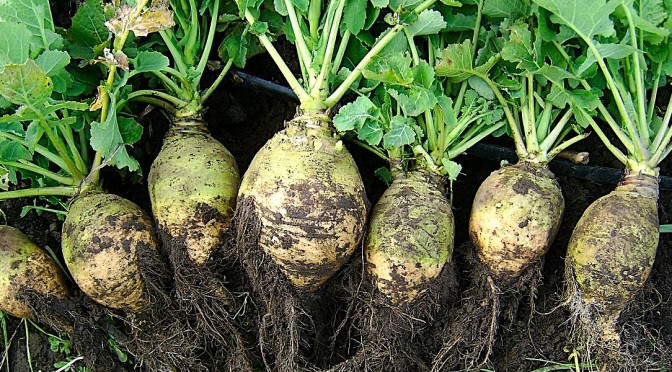Back quite a few years ago, PK and I put on a Scandinavian feast for the local SCA group. For the uninitiated, that’s the Society for Creative Anachronisms, a medieval recreation group. We tried to find recipes that would go back to the Middle Ages for the feast and it included many interesting and diverse foods from Scandinavia. One of the dishes we made was Lanttulaatikko, which is a rutabaga baked casserole from Finland. It was the first time I used rutabagas and I was pleasantly surprised by their taste. I have only used them rarely since then and now find myself wondering why? They are fairly low carb, although most of the carbs are sugar, and can be used in much the same way as a potato, so I plan to enjoy them more often in my cooking.
Rutabagas have a bit of a confused history, largely because of a mix of names used for them. They are only called rutabagas in the United States and possibly, Canada. Most of the rest of the world calls them swedes, reflecting back to their abundance in Sweden. The name itself is of Swedish origin, coming from rotabagge, meaning “round root”.
Other names for them are Swedish turnips and Russian turnips. In Ireland, they are the “neeps” in “tatties and neeps”, confusing matters further. I mentioned turnips to a friend who had lived in Ireland and she thought I was referring to a rutabaga. While they are believed to be a hybrid between a turnip and a wild cabbage, they have developed a different look and a different taste from a turnip. The vegetable is larger than a turnip with a purple to tan colored skin and the flesh is an orange color with a nutty, sweet taste when roasted. Turnips are white with a bit of purple on them, although some are all white and the flesh part is white and has a slight peppery taste. I’m sure that clears things right up.

Rutabagas are a cold weather crop, like turnips, kohlrabi and others from the turnip family. They are primarily grown in the northern United States, Canada, Europe, and Great Britain.
Uses
Rutabagas can be cooked almost any way you cook a potato — roasted, sautéed, baked, fried, boiled, mashed and added to soups and stews. They can be shredded and added raw to salads. They make great French fries.
Fun Facts about the rutabaga
In 2011, the rutabaga entered the Guinness Book of World Records as the world’s largest vegetable when a gardener in the U.K. grew one that weighed 85.5 pounds! That is a big rutabaga!
People in the British Isles used to carve turnips and their larger cousins, the rutabaga into their equivalent of the pumpkin on Halloween. Called ‘tumshie heads” the children would carry them to ward off evil spirits. They have now been replaced for the most part with pumpkins.
The annual Rutabaga Curling Championship takes place annually at the Ithaca, New York, Farmers’ Market on the last day of the market season. They literally hurl or curl the rutabagas across the wooden floor.
Nutrition Information per 1 cup of cubed rutabaga (170 grams)
Calories: 66 Fat: 0 g Net Carbs: 12 g Protein: 2 g
Recipes
Here’s a couple of recipes from the Skinny Girl site that use rutabagas:
Corned Beef Hash with Eggs
Cove Soup
Featured Recipe for this blog:

Lanttulaatikko- Finnish Rutabaga Bake
I originally found this recipe in the Betty Crocker International Cookbook and have only made a couple of changes to it to convert it to low carb.
2 to 3 medium Rutabagas, peeled and diced (about 6 cups)
2 Tablespoons Butter, divided
1/2 cup Cream
1/4 cup Water
1/2 cup Low Carb Breadcrumbs
1 teaspoon Salt
1/2 teaspoon Nutmeg
2 Eggs, slightly beaten
2 tablespoons Sugar-Free Pancake Syrup
Cooking spray
Cover rutabaga cubes in water in a large saucepan. Bring to a boil, then reduce the heat and simmer until fork tender. This is about 20 to 30 minutes. Drain and put in your food processor to puree or use a hand masher. Set aside to cool a little.
Preheat oven to 350 degrees (F.) Spray a casserole dish with cooking spray.
Mix together two tablespoons of the butter, cream, syrup, salt, nutmeg, breadcrumbs and eggs until well mixed, then add to the mashed rutabagas. Pour into the prepared casserole dish. Dot the rest of the butter over the top.
Bake for 45 minutes or until the top is lightly browned.
Makes 8 servings
Nutirion Info per serving:
Calories: 146.1 Fat: 11.3g Net Carbs: 6.4 g Protein: 3.2 g
Information for this article came from Food Facts, Vegetarian in Paradise, Specialty Produce and Wikipedia.
Photo at the top from Wikimedia, used with permission – “Rutabaga, variety nadmorska” by Picasa user Seedambassadors –
All other photos by Rene Averett; copyright Skinny Girl Bistro

